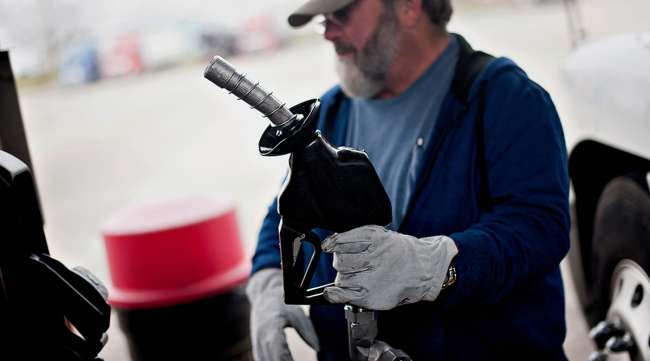Senior Reporter
Diesel Falls 2.7¢ to $3.037 Per Gallon

[Stay on top of transportation news: Get TTNews in your inbox.]
The U.S. average retail price of diesel fell 2.7 cents to $3.037 a gallon, the Department of Energy reported Jan. 21, a day after the Martin Luther King Jr. federal holiday. Oil futures slipped lower Jan. 23 amid abundant supplies and fears the coronavirus outbreak in China could spread globally and affect demand.
Trucking’s main fuel costs 7.2 cents more than it did a year ago, when it was $2.965 a gallon, according to DOE.
Regional diesel prices fell in all areas except New England, where it rose 0.1 cent.
U.S. average #diesel fuel price on 1/20/2020 was $3.037/gal, DOWN 2.7¢/gallon from 1/13/2020, UP 7.2¢/gallon from year ago https://t.co/yoQIP6jFvC #truckers #shippers #fuelprices pic.twitter.com/3c2HrpZGnh — EIA (@EIAgov) January 22, 2020
The U.S. average price of a gallon of gasoline fell 3.3 cents to $2.537 per gallon, according to DOE’s Energy Information Administration. It costs 28.6 cents more than a year earlier.
Average gasoline prices fell in all regions.
U.S. regular gasoline retail prices averaged $2.60 a gallon in 2019, and EIA forecasts they will average $2.63 in 2020 and 2021.
Meanwhile, XStream Trucking announced its product TruckWings, which encloses the tractor-trailer gap, landed in the fastest-growing area for fuel economy in the 2019 Annual Fleet Fuel Study recently released by the nonprofit North American Council for Freight Efficiency.
In the study, 8.2% of responding fleets reported they were adopting trailer-gap reducers compared with 0.6% a year earlier, according to NACFE. TruckWings is bolted behind the cab. Top and side panels unfold automatically when a truck reaches a certain speed. They refold by themselves when the open gap is needed for the truck to make a turn, according to the Redwood City, Calif.-based company.

The TruckWings top and side panels unfold when the truck reaches a designated speed. (XStream Trucking Inc.)
XStream reported TruckWings has been deployed by fleets in 45 million miles of highway driving, reducing carbon emissions by more than 7 million pounds as the fleets collectively notched fuel savings of $1.04 million — assuming the trucks achieved 7 miles per gallon and diesel fuel cost $3.25 per gallon, which would result in a 5% fuel savings.
“First of all, putting something on the back of the cab and not having it get damaged is something I didn’t think anyone would ever figure out. XStream is making it work. That is a great success story,” NACFE Executive Director Mike Roeth told Transport Topics.
He said the fuel-efficiency gains from enclosing the tractor-trailer gap have proved to be higher than what wind tunnel testing has shown. “What we are finding, which is completely contrary to every other technology, is that [enclosing the gap] is actually performing better in the real world. It is not only XStream, there are other people who have built different ones. These three or four [companies] have all had better performance in the field.”
He attributed that to the devices’ ability to reduce the effect of sidewinds encountered while driving, which are stronger than those applied in wind tunnels.
Meanwhile, Roeth said idle reduction continues to be “a huge conundrum for fleets.” Electric and diesel auxiliary power units are expensive, and questions remain about the residual value of APUs in the used truck market.
“At the same time, drivers are becoming more demanding. They want cool cabs. They want uninterrupted electricity. If you have a CPAP device and you run out of juice …,” he said. “It’s frustrating for drivers and fleets. They are not sure what to do. The driver expectations are only going to go up.”
Overall, NACFE’s fuel report contains the results of a deep-dive investigation into the adoption of various products and practices for improving freight efficiency among 20 major North American fleets, according to the group.
Separately, Volvo Trucks North America is an advocate of turbo compounding, a waste-heat recovery system that uses a turbine to convert energy from the exhaust gases to increase torque and fuel efficiency.
VTNA, a unit of Volvo Group, reported its original D13TC engine’s turbo compounding unit adds 50 horsepower and improves fuel efficiency by up to 7.5% compared with GHG14 engines.
NACFE 2019 Annual Fleet Fue... by Transport Topics on Scribd
“The recently launched next-generation D13TC engine, available mid-2020, will add up to 3% more fuel efficiency,” John Moore, VTNA’s product marketing manager, told Transport Topics.
Because of the boost in fuel efficiency, the truck maker believes turbo-compounding technology could reach the same level of market acceptance as its automated transmissions, which is just more than 90%.
West Texas Intermediate crude futures on the New York Mercantile Exchange closed at $58.34 on Jan. 21 compared with $58.08 per barrel Jan. 13.
EIA forecasts that the United States will be a net exporter of total crude oil and petroleum products by 800,000 barrels in 2020 and by 1.4 million in 2021. The WTI spot price will average $59 a barrel in 2020 and $62 in 2021, driven by market fundamentals.
Want more news? Listen to today's daily briefing:




